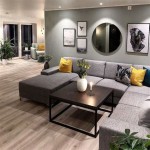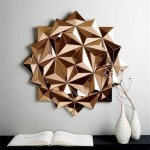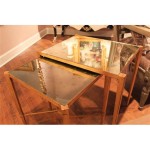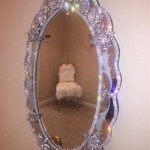What Does a Two-Way Mirror Mean?
A two-way mirror, also known as a one-way mirror or half-silvered mirror, is a specialized type of mirror that allows viewing from one side while appearing reflective on the other. This seemingly paradoxical functionality stems from the precise application of a reflective coating to a glass surface. Unlike traditional mirrors that feature a fully opaque reflective backing, two-way mirrors possess a thin, semi-transparent metallic coating. This coating reflects some light and allows some to pass through, creating the unique optical properties that define these mirrors.
The key to understanding how two-way mirrors work lies in the concept of light transmission and reflection. When light strikes any surface, a portion is reflected, and a portion is transmitted or absorbed. Standard mirrors reflect nearly all incident light, creating a clear reflection. Two-way mirrors, with their thinner metallic coating, reflect approximately half of the incoming light while allowing the other half to pass through. This balance between reflection and transmission is the foundation of their functionality.
The effectiveness of a two-way mirror depends heavily on the lighting conditions on either side of the glass. The viewing side must be significantly darker than the observed side. In a brightly lit room, a substantial amount of light is reflected back from a two-way mirror, creating a mirror-like appearance. If the room on the other side is dimly lit, very little light is transmitted through the mirror from that side. The difference in light levels makes the reflection dominant, effectively hiding the observation area behind the mirror.
Conversely, if the lighting conditions are reversed, with the observation area brightly lit and the observed area dim, the functionality of the two-way mirror is compromised. The higher light level on the observation side will transmit through the mirror, making the observation area visible from the other side. This highlights the critical role lighting plays in maintaining the illusion of a one-way mirror.
Common applications of two-way mirrors exploit this dependence on lighting differences. Security and surveillance applications often utilize two-way mirrors in interrogation rooms or observation areas. The brighter lighting in the observed room creates a reflective surface for occupants, while observers in the darkened adjacent room can clearly see through the mirror. Similar principles apply to the use of two-way mirrors in research settings, enabling observation of subjects without their awareness.
Architectural applications also make use of two-way mirrors, often for creating illusions of space or for aesthetic purposes. In these cases, careful control of lighting is essential to maintain the desired effect. Two-way mirrors can be integrated into interior designs to create hidden spaces or to add a sense of depth and intrigue. The ability to manipulate the transparency of the mirror through lighting control offers unique design possibilities.
The manufacturing process of two-way mirrors involves the delicate application of a metallic coating, typically silver or aluminum, to a glass surface. This coating is applied in a very thin and uniform layer, carefully controlled to achieve the desired level of reflectivity and transmission. The thickness of this layer determines the ratio of light reflected to light transmitted, directly impacting the effectiveness of the two-way mirror. Vacuum deposition techniques are commonly employed to achieve the precise control required for this process.
Beyond security and architecture, two-way mirrors also find application in entertainment and illusion. Stage magic often incorporates two-way mirrors to create disappearing acts or other visual effects. The manipulation of lighting and carefully positioned mirrors can create convincing illusions that captivate audiences. These applications demonstrate the versatility of two-way mirrors and their ability to manipulate perception.
It is important to note that achieving the desired effect with a two-way mirror requires careful consideration of the entire environment. Factors such as ambient light, the color of the surrounding walls, and the positioning of light sources can all influence the effectiveness of the mirror. Professional installation and careful light management are essential for maximizing the functionality and ensuring the intended illusion is maintained.
The term "two-way mirror" can sometimes be misleading. While the mirror allows vision in both directions under certain lighting conditions, the term primarily refers to the intended usage - observation from one side while maintaining a reflective appearance on the other. This nuanced functionality distinguishes two-way mirrors from standard mirrors and allows for their diverse range of applications.
Identifying a two-way mirror can be challenging, as it often appears identical to a regular mirror under normal lighting conditions. One method involves observing the reflection closely. If the reflection appears slightly darker than expected, or if there is a faint image of what lies behind the mirror, it might be a two-way mirror. Another technique involves placing a fingernail against the surface of the mirror. With a regular mirror, a small gap will be visible between the fingernail and its reflection due to the glass layer. With a two-way mirror, the reflection will appear to touch the fingernail directly due to the metallic coating being on the surface.

How To Tell If A Mirror Is Two Way Or Not 8 Steps With Pictures

How To Tell If A Mirror Is Two Way Or Not 8 Steps With Pictures

Don T Believe Everything You See 9gag
A Mirror Or 2 Way Glass

Double Sided Mirror Meaning Tiktok Search

2way Mirror Two Way A Guide To Deduction Handy Dandy

How To Build A Super Slim Smart Mirror Raspberry Pi

Double Sided Mirror Meaning Tiktok Search

Do People See You Inverted Your Questions Answered

Conair Double Sided Lighted Vanity Mirror With Led Lights 1x 7x Magnification Chrome Be157 Com








